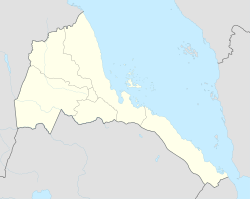Adulis
This article needs additional citations for verification. (February 2022) |
𐩱 𐩵 𐩡 𐩪 ኣዱሊ | |
 | |
| Location | Eritrea |
|---|---|
| Region | Northern Red Sea |
| Coordinates | 15°15′47″N 39°39′38″E / 15.263061°N 39.660552°E |
Adulis (Sabaean: ሰበኣ 𐩱 𐩵 𐩡 𐩪,
History
Pliny the Elder is the earliest European writer to mention Adulis (N.H. 6.34). He misunderstood the name of the place, thinking the toponym meant that it had been founded by escaped Egyptian slaves. Pliny further stated that it was the 'principal mart for the Troglodytae and the people of Aethiopia'. Adulis is also mentioned in the Periplus of the Erythraean Sea, a guide of the Red Sea and the Indian Ocean. The latter guide describes the settlement as an emporium for the ivory, hides, slaves and other exports of the interior. Roman merchants used the port in the second and third century AD.

A fourth century work traditionally (but probably incorrectly) ascribed to the writer Palladius of Galatia, relates the journey of an anonymous Egyptian lawyer (scholasticus) to India in order to investigate Brahmin philosophy.[citation needed] He was accompanied part of the way by one Moise or Moses, the Bishop of Adulis.
Control of Adulis allowed Axum to be the major power on the
Archeological excavations
Adulis was one of the first Axumite sites to undergo excavation, when a French mission to Eritrea under Vignaud and Petit performed an initial survey in 1840, and prepared a map which marked the location of three structures they believed were temples. In 1868, workers attached to Napier's campaign against Tewodros II visited Adulis and exposed several buildings, including the foundations of a Byzantine-like church.

The first scientific excavations at Adulis were undertaken in 1906, under the supervision of Richard Sundström. Sundström worked in the northern sector of the site, exposing a large structure, which he dubbed the "palace of Adulis", as well as recovering some examples of Axumite coinage.[6]
The Italian Roberto Paribeni excavated in Adulis the following year, discovering many structures similar to what Sundström had found earlier, as well as a number of ordinary dwellings. He found a lot of pottery: even wine amphorae imported from the area of modern
Over 50 years passed until the next series of excavations, when in 1961 and 1962 the Ethiopian Institute of Archeology sponsored an expedition led by Francis Anfray. This excavation not only recovered materials showing a strong affinities with the late Axumite kingdom, but a destruction layer. This in turn prompted Kobishchanov to later argue that Adulis had been destroyed by an Arab raid in the mid-7th century, a view that has since been partially rejected.[citation needed]
A pair of fragments of glass vessels were found in the lowest layers at Adulis, which are similar to specimens from the
Since Eritrean Independence, the National Museum of Eritrea has petitioned the Government of Ethiopia to return artifacts of these excavations. To date they have been denied.[9]
Previous colonial researches were underpinned by an old Ethiopian narrative. Most of these chronicles puts Adulis smack-dab at the middle of the Axumite kingdom and subsumes it as an integral part of this very kingdom. As a result, Adulis has been studied as part and parcel of the Axumite kingdom by most, if not all, scholars of the region. However, recent historical/archaeological sources challenge the Abyssinian paradigm in the sense that Adulis was the center of a kingdom that was not a constituent part of the Axumite kingdom, on the earlier period prior to the emergence of Aksum.[citation needed]
See also
Notes
- ^ Stephanus of Byzantium, Ethnica, §A26.18
- ISBN 9789004362321. Retrieved May 18, 2021 – via Google Books.
- ^ Pfeiffer, Stefan: Griechische und lateinische Inschriften zum Ptolemäerreich und zur römischen Provinz Aegyptus. Münster: Lit, 2015, p. 56-61.
- .
- ^ Peter Thonemann, "Gates of Horn", p. 9
- ^ Published as part of Enno Littmann, "Preliminary Report of the Princeton University Expedition to Abyssinia with a contribution by Richard Sundström", 20 (1907), pp. 172-182
- ^ Paribeni in Adulis Archived July 11, 2013, at the Wayback Machine
- ^ Leclant, Jean (1993). Sesto Congresso internazionale di egittologia: atti, Volume 2. International Association of Egyptologists. p. 402. Retrieved 15 September 2014.
- ^ "Eritrea wants artefacts back". 2005-10-02. Archived from the original on 2006-06-20. Retrieved 2007-02-05.
Further reading
- ISBN 978 0 19 973932 5(reviewed by Peter Thonemann in "Gates of Horn", Times Literary Supplement, 6 December 2013, pp. 9–10)
- ISBN 0-7486-0106-6
- Yuri M. Kobishchanov. Axum (Joseph W. Michels, editor; Lorraine T. Kapitanoff, translator). University Park, Pennsylvania: Pennsylvania State Univ. Press, 1979. ISBN 0-271-00531-9
- David Peacock and Lucy Blue (ed.) The Ancient Red Sea Port of Adulis, Eritrea (Oxford: Oxbow, 2007) ISBN 978-1-84-217308-4



